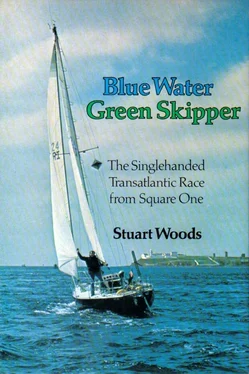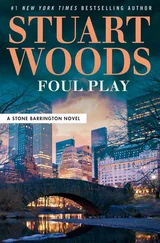Harp surfed down the big waves, often exceeding her theoretical hull speed of about eight knots. I have one vivid memory of sitting in the watch seat, watching the instrument dials; the yacht suddenly accelerated to nine knots, surfing down a wave, and the wind-speed indicator was registering a steady forty-five knots with the wind dead astern. This meant a true wind speed of fifty-five knots, or more than sixty miles an hour. The noise and spray were incredible, but knowing that I had a good boat under me, it was not frightening but exhilarating.
Now my spare navigation lights failed. On reaching Horta I had found that the masthead light had simply disappeared, blown away on the passage out. Now, with the spares gone, too, I was reduced to one small, battery-operated white light, which I taped to a stanchion so that it could be seen all round. In a lull, when I started to unreef the genoa a bit, the Dynafurl parted again, the top half of the top swivel staying up the mast with the halyard and the bottom half sliding down the Twinstay with the sail. As long as the wind was behind us this did not pose much of a problem, since we could still sail very fast under the double-reefed main only, so I lashed the sail to the deck along with the number-one genoa and sailed on. I would have to climb the mast and retrieve the top half of the swivel before I could set a headsail again. Quite apart from the weakness in the Dynafurl, which would have to be redesigned, this meant that there was a gap in my sail plan. The smallest sail I had aboard was the number-two reefing genoa, which meant that if the Dynafurl failed in heavy weather I needed a smaller sail to set until I could repair it. I would have a lot of rethinking to do when I reached Ireland, but then, that was what the qualifying cruise was for — to expose weaknesses in the boat and her systems. On that basis my cruise from the Azores was already an outstanding success.
The storm continued for nearly three days, with the wind only occasionally dropping to gale force. My reaction to being tossed about was, surprisingly, not fear but anger. I found it difficult to sleep, because when the boat mini-broached and woke me up my anger at being awakened made it difficult for me to go back to sleep. This cut into my reserves of strength, and the constant bailing kept me tired, but I became really exhausted only once.
At dusk on the thirteenth, I went into the cockpit to change the battery for the navigation light and discovered to my horror that both the number-one and — two genoas were dragging in the water, attached to the boat by only a shackle at their tacks. If I lost those sails, or even if they were badly torn, I would have no headsail to set and would be at the mercy of the wind, unable to sail in any direction but downwind. I was afraid to stop the boat and let her lie ahull, abeam to the seas, so I left her on her course, got into a safety harness, clipped onto a jackstay, and crawled forward to the foredeck, where I could reach the overboard sails.
With the additional drag from the two big sails, the boat had slowed to about four knots and was heeled more sharply. Large amounts of seawater were washing over me, and when I began to try to pull the sails aboard I discovered that they seemed hopelessly entangled in the lines, now broken, which had been laced through the guardrails to keep the sails on deck. Also the drag on the sails was incredible. It was like trying to haul in nets full of fish, single-handed.
As if all that wasn’t enough, I began to hallucinate. I had read about the hallucinations of single-handed sailors. Joshua Slocum believed he had been assisted by a Portuguese seaman from another era, who appeared when he needed help. Others have written of shouts from on deck when something had gone wrong. Still others have seen and talked with friends or relatives. My hallucination was somewhat more mundane. The telephone rang.
Of course, there was no telephone on Golden Harp, but that did not stop it from ringing. What’s more, it was a French telephone, like the instrument in a cheap Paris hotel room. It rang and rang. It was a bit like being in the bath, hearing the phone ring and being unable to answer it. My thought process went: Dammit, there’s the phone, must answer it; no, can’t answer it, got to get these sails aboard again; wait a minute, stupid, there is no telephone... There’s the phone, must answer it... It went on and on as I struggled with the sails, the same thought pattern turning over and over in my head; I could no more stop it than I could stop the phone from ringing.
It took me more than an hour to haul the sails aboard again and secure them, the whole of the time being drenched, often with my feet dragging in the water as I tried to find a position where I could get a better grip and more purchase on the dragging canvas. Twice I almost lost a seaboot, rescuing it just as it was being washed from my foot. Finally, I had both sails aboard on the foredeck, lying spread-eagle on top of them to keep them from going again. Foot by foot I slid their bulk back toward the cockpit, taking infinite pains to see that no part of them slipped overboard again, because now they were attached to nothing except me. I made the cockpit, pushed the sails in ahead of me, then collapsed on top of them. At last, I thought, I can answer the telephone. It stopped ringing, just as it always does when you’ve struggled out of the bath and, clutching a towel about you, raced through the house, leaving a trail of wet footprints. Later, when I told a friend about this, she said, “Suppose it hadn’t stopped ringing.” That is a terrifying thought.
I lay in the cockpit for half an hour, not even budging when another squall hit. After all, Harp was steering herself, and I couldn’t get any wetter. I think that if anything else had gone wrong at that moment I would have been unable to do anything about it. It is that degree of helpless exhaustion which is so dangerous to the single-hander. Sometimes, if you can’t cope you can’t live. It’s as simple as that.
Soon after this delightful evening the storm began to abate and the wind veer. By morning the wind was ahead of the beam, still blowing about thirty knots. We were close reaching under double-reefed main only and our speed was down to two knots. Without a headsail we were going to make little progress, and if the wind continued to veer we would end up pointing at France instead of Ireland. There was nothing to do but go up the mast, retrieve the halyard, fix the Dynafurl, and get a headsail up. I made my first attempt almost immediately; I got about two steps up the mast, a forty-knot squall hit, and I was quickly down and into the cabin again, very chastened.
Next day, Sunday, I tried again. The wind had dropped further, but there was still a big sea running and, the wind having veered, it was now coming from two directions. I got as far as the crosstrees this time before I chickened out and retreated to wait for the seas to go down. Finally, late Monday afternoon, I made one last assault on the mast. I ran the boat off to steady her as much as possible, got into a harness, and started laboriously up the stick, clipping one of the two stainless-steel carbine hooks onto a higher step before unclipping the lower one. That way if I slipped I would always be hooked onto something, although I didn’t relish the thought of swinging around like a pendulum from a rope clipped to a mast step. I stopped at the crosstrees to rest my hands, which were already very tired from gripping the steps so tightly, then continued. Step, hook to next step, unhook from lower step, step again. It went that way for all of the mast’s thirty-eight-foot height, until finally I was clinging desperately to the top, both arms wrapped in a bear hug around the mast. It was necessary to hold on very tightly still, for the boat was rolling in the confused seas, and the mast was cutting an arc of fifteen to twenty feet at the top. Had I lost my grip there would have been a kind of slingshot effect, and I would have been catapulted off the mast into the sea. I stuck an arm through a mast step so that I would have a free hand, praying that the boat would not do a snap roll and break it at the shoulder, and started to haul down on the halyard.
Читать дальше












